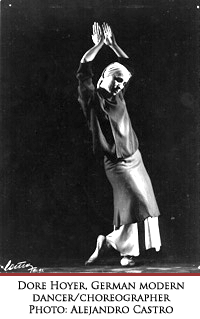 | ||||||||
Wigman responded in her letters: Darling, if you do come, I think your program will not be long enough as one expects from a real stage dancer ... you should have some variety ... the dances we know already are ok, but they are more or less on the same level of expression. You should have at least one gay dance and one of real dramatic character ... Otherwise it might be too big a waste of strength and money ... I am being very honest because I want you so much to be impressive ...
Judy's appearance in Berlin came in the shadow of the death of the great Expressionist dancer Dore Hoyer, who had taken her own life at the age of 56 on the last day of 1967. We all lost our best dancer of all time. Her last dance performance was wonderful. She got the "critiker prize" and the best reviews. But she wanted to go at the height of her Power. For a time, it seemed, there was speculation that Judy might assume her place in the cycle of dance as a revered solo dancer. Jarvis' Berlin concert was a great success. ... a girl dancing swiftly and-technically-faultlessly: Judy Jarvis. Whoever had thought that with the decease of the great Dore Hoyer expressive dancing in its highest, purest form had gone out of the world, had to correct his opinion. Here it came back to us young and full of life -- as a Renaissance. (read review) In short, in the clever concentrated expressionist studies could be seen a great technique -- and a constant surprise of a kind of joy that shone to the memory of Dore Hoyer. The Expressionist Dance is not dead. It has found in the new generation a new protagonist. (read review) In July 1968, Judy wrote her mother: The audience gave me a standing ovation and I had to repeat two dances Amen and Marriage Song. I have been named the successor to Dore Hoyer, Europe's greatest solo dancer ... ©2005, Dance Collection Danse | ||
 Judy persevered and remarkably she was able to return to Germany in 1968 to visit Mary Wigman and to dance at Berlin's Schaubuhne Theatre on June 29th. She wrote excitedly of "big red and black and white posters all over Berlin". She spent $800 to rent the 550-seat theatre.
Judy persevered and remarkably she was able to return to Germany in 1968 to visit Mary Wigman and to dance at Berlin's Schaubuhne Theatre on June 29th. She wrote excitedly of "big red and black and white posters all over Berlin". She spent $800 to rent the 550-seat theatre.
